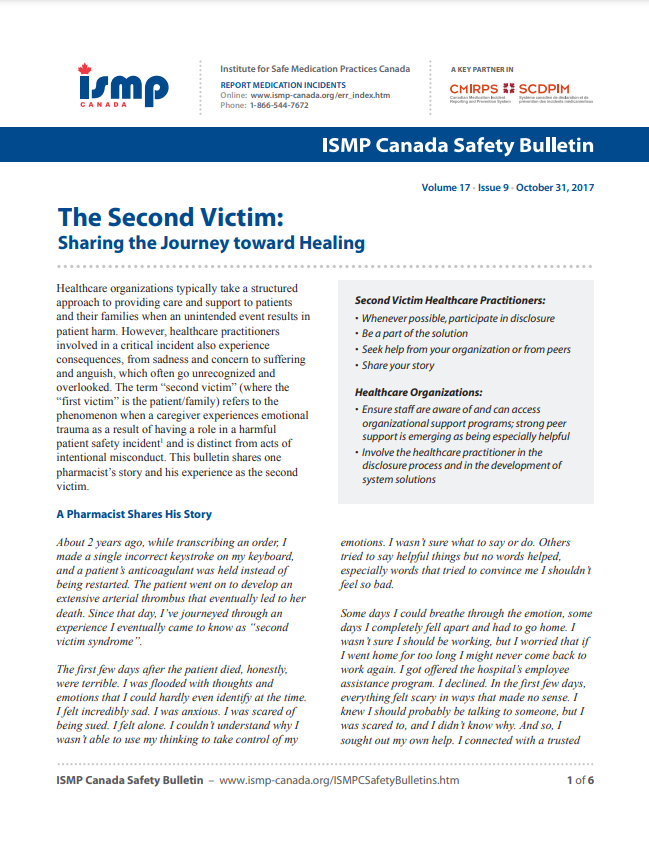INTRODUCTION
Healthcare organizations typically take a structured approach to providing care and support to patients and their families when an unintended event results in patient harm. However, healthcare practitioners involved in a critical incident also experience consequences, from sadness and concern to suffering and anguish, which often go unrecognized and overlooked. The term “second victim” (where the “first victim” is the patient/family) refers to the phenomenon when a caregiver experiences emotional trauma as a result of having a role in a harmful patient safety incident1 and is distinct from acts of intentional misconduct. This bulletin shares one pharmacist’s story and his experience as the second victim.
Second Victim Healthcare Practitioners:
- Whenever possible, participate in disclosure
- Be a part of the solution
- Seek help from your organization or from peers
- Share your story
Healthcare Organizations:
- Ensure staff are aware of and can access organizational support programs; strong peer support is emerging as being especially helpful
- Involve the healthcare practitioner in the disclosure process and in the development of system solutions
A PHARMACIST SHARES HIS STORY
About 2 years ago, while transcribing an order, I made a single incorrect keystroke on my keyboard, and a patient’s anticoagulant was held instead of being restarted. The patient went on to develop an extensive arterial thrombus that eventually led to her death. Since that day, I’ve journeyed through an experience I eventually came to know as “second victim syndrome”.
The first few days after the patient died, honestly, were terrible. I was flooded with thoughts and emotions that I could hardly even identify at the time. I felt incredibly sad. I was anxious. I was scared of being sued. I felt alone. I couldn’t understand why I wasn’t able to use my thinking to take control of my emotions. I wasn’t sure what to say or do. Others tried to say helpful things but no words helped, especially words that tried to convince me I shouldn’t feel so bad.
Some days I could breathe through the emotion, some days I completely fell apart and had to go home. I wasn’t sure I should be working, but I worried that if I went home for too long I might never come back to work again. I got offered the hospital’s employee assistance program. I declined. In the first few days, everything felt scary in ways that made no sense. I knew I should probably be talking to someone, but I was scared to, and I didn’t know why. And so, I sought out my own help. I connected with a trusted colleague who had experienced something similar, and that helped me feel less alone. I connected with a friend in pastoral care, and we just sat together. I did some art in the hopes of processing parts of the experience [see Figure 1].

Figure 1. Paintings by the pharmacist after the incident, expressing the physical symptoms he felt while travelling to work.
Eventually, the initial flood of emotion dissipated. Over months, my intense sadness became periodic moments of tears. Instead of feeling scared, I found myself feeling risk averse. The symptoms would come and go unexpectedly. I wanted to find a pattern or a trigger I could control, but there didn’t seem to be any. I started to get frustrated with the unpredictability and the length of time it was taking to show any improvement.
I finally started seeing a social work counsellor who helped me. She helped me realize that the feelings I was having were normal, and helped me identify them as grief. And she taught me that grief is a long and slow process that can’t be hurried and isn’t predictable.
After more than a year had passed, I remember feeling that I was almost back to normal. I caught glimpses of my former happy, joyful self. Slowly these glimpses became more frequent and lasted longer. And now, almost 2 years later, I mostly feel like my old self again. I still occasionally have an unexpected, unexplained moment of grief; but what has persisted is my reduced ability to hold back my emotions. It’s like the barrier I used to keep around my emotions got a little bit weaker, and my feelings leak through more easily. Maybe that’s not such a bad thing, but it’s taking some getting used to.
EMOTIONAL DISTRESS OF THE SECOND VICTIM
A healthcare practitioner who is involved in an incident that causes harm to a patient can be left devastated; the pharmacist’s description above illustrates the extent to which some individuals can experience emotional distress. It is estimated that up to 50% of healthcare practitioners experience second victim syndrome at some point in their careers.2 The psychological impact of an error on the healthcare practitioner is thought to be similar to that characterizing post-traumatic stress disorder, and this effect can be long-lasting.3 Figure 2 shows the range of psychological and emotional responses that practitioners deal with when reconciling their involvement in an incident. These practitioners often feel doubt in their ability to perform at work, worry about their potentially negative impact on future patients, and may develop frequent absenteeism.3

Figure 2. The second victim’s psychological and emotional responses.4,5
THE SECOND VICTIM'S COPING STRATEGIES
Most practitioners cope by reviewing the details of the harmful incident, seeking emotional support from colleagues, and trying to understand and learn from the event, as part of the healing process.5,6 Although many healthcare organizations recognize the need to assist the practitioner involved in a critical incident (e.g., through an employee assistance program [EAP]), most may not be prepared to meet a range of needs. Peer support (e.g., from clinical co-workers) appears to be preferred over support from externallyemployed professionals (e.g., mental health specialists).6,7 This preference, as well as doubts about confidentiality, may lead second victims to avoid accessing their EAP. Box 1 highlights some of the other barriers that second victims encounter when seeking support from their workplace.
Box 1.
Barriers Faced by Second Victims Seeking Support7,8
- Inadequate organizational safety culture
- Stigma associated with reaching out for help
- Fear of loss of professional respect
- Fear of loss of income
- Difficulty taking time off work
- Doubts about confidentiality of services offered
- For contracted or casual employees, lack of available organizational support
Box 1.
Barriers Faced by Second Victims Seeking Support7,8
ORGANIZATIONAL IMPACT AND RESPONSIBILITY
An organizational culture of safety, including openness to discussing errors, allows affected practitioners to reach out and access help without any stigma. This fundamental workplace characteristic may reduce additional barriers noted in Box 1. A perceived low level of organizational support has been linked to negative second victim outcomes, such as ongoing emotional distress, intention to leave employment, and absenteeism, whereas strong peer support has been a major factor in avoidance of these negative outcomes.3
Recent literature on the topic has identified peer support as an essential component in alleviating impacts on the second victim.3,4 Some organizations, such as the University of Missouri Health System and Johns Hopkins Hospital, have developed peer-to-peer support programs as a method of providing this type of assistance.8,9
RECOMMENDATIONS
Second Victim Healthcare Practitioner
Every healthcare practitioner involved in a patient harm incident might have a unique emotional response and staged healing process. The pharmacist’s story highlighted the following recommendations as actions that assisted him while he worked through the emotions that he experienced after the incident, including his confidence and psychological well-being. His commentary is included.
Recommendation: Whenever possible, participate in disclosure. Patients and families can be surprisingly forgiving when the error is disclosed by a caring practitioner with a sincere apology.1 Carrying out disclosure might require support and emotional coaching from internal risk management/patient relations staff.
Pharmacist’s Commentary: The team and I met with the patient and her family on several occasions following the incident, but prior to the patient’s death. Even though I knew it was the right thing to do, part of me was scared to do so. When the family came to the hospital months later to discuss the events, they remembered me, asked how I was doing, and mentioned how honest and compassionate and caring I was. That went a long way toward my healing.
Recommendation: Seek help. Inquire about programs or processes in place to support second victims.
Pharmacist’s Commentary: Even if your organization does not have formal supports in place, you can be part of getting the process started.
Recommendation: Be part of the solution. Participating in the incident review process and learning about any inadequacies identified can lessen the emotional distress associated with waiting for follow-up.
Pharmacist’s Commentary: We had a meeting eventually to review the events and develop strategies to reduce their likelihood in the future. And even though the scared part of me didn’t want to go, I knew it was the right thing to do, and I went. Being part of the solution is a healthy way of processing the experience.
Recommendation: Recognize that human errors happen to all practitioners, regardless of their level of skill and experience. Healthcare systems often lack adequate prophylactic measures to prevent all such errors and need to be improved to avoid unintended patient harm.
Pharmacist’s Commentary: I believe it was this deep-rooted idea that helped spare me from another devastating feeling that often accompanies second victim syndrome: guilt. I had tremendous grief, but not guilt or self-doubt. I knew I wasn’t the problem.
Recommendation: Share your story. Most second victims welcome conversations with colleagues about their experience. Retelling the event to a peer who has had a similar experience can be a powerful tool in the healing process. Sharing stories with a supportive colleague who is not judgmental and who does not lay blame can give the second victim insight and reassurance.10 Reporting the adverse event to ISMP Canada through the Individual Practitioner Reporting program (www.ismp-canada.org/err_ipr.htm) can facilitate widespread learning from one person’s experience.
Pharmacist’s Commentary: If you’re along the road to recovery, share your story. It’s a story worth retelling.
Healthcare Organizations
The following actions by healthcare organizations can support the second victim:
- Support the practitioner. Provide access to and educate staff about organizational supports that are available to second victims. Strong peer support has emerged as being especially helpful for second victims. For organizations without such infrastructure, a toolkit9 developed by an expert group is available, in addition to additional resources from Johns Hopkins8 and the University of Missouri Health System.9 A recent cost analysis has shown that a peer support program can lead to cost savings for hospitals.11
- Whenever possible involve the practitioner in the disclosure process. The Canadian Incident Analysis Framework shares a checklist to support effective meetings with families.12
- Involve the affected practitioner in the analysis of why the incident occurred and the development of solutions to system problems identified. The Framework can also be used to provide guidance to the process.12
- Offer the second victim the opportunity to share his or her story. This may help with the healing process and may support others going through the same process.
- Create a culture of safety. A supportive and fair culture facilitates discussion and sharing, promotes reporting of incidents and near misses, and creates opportunities for learning.
- Treat the practitioner fairly (see Box 2). Proactive interventions to support a culture of safety can mitigate the negative effects experienced by the second victim.
- Develop programs* to promote awareness of, as well as to provide education about, the second victim syndrome to help colleagues understand how to support the practitioner following a harmful incident.13

Box 2. Five Rights of a Second Victim14
CONCLUSION
More is becoming known about the second victim phenomenon and how to best support practitioners when adverse patient events occur. Organizations can nurture a workplace culture in which “second victims” are unafraid to seek help and establish or strengthen practitioner support programs. Colleagues, especially those who have gone through similar experiences, can play the vital role of listener and supporter. Practitioners taking part in the disclosure process and working with the patient/family and the organization to identify solutions can support the healing for all involved.
![]()
The Canadian Medication Incident Reporting and Prevention System (CMIRPS) is a collaborative pan-Canadian program of Health Canada, the Canadian Institute for Health Information (CIHI), the Institute for Safe Medication Practices Canada (ISMP Canada) and Healthcare Excellence Canada (HEC). The goal of CMIRPS is to reduce and prevent harmful medication incidents in Canada.
Funding support provided by Health Canada. The views expressed herein do not necessarily represent the views of Health Canada.

The Healthcare Insurance Reciprocal of Canada (HIROC) provides support for the bulletin and is a member owned expert provider of professional and general liability coverage and risk management support.

The Institute for Safe Medication Practices Canada (ISMP Canada) is an independent national not-for-profit organization committed to the advancement of medication safety in all healthcare settings. ISMP Canada’s mandate includes analyzing medication incidents, making recommendations for the prevention of harmful medication incidents, and facilitating quality improvement initiatives.
Report Medication Incidents (Including near misses)
Online: ismpcanada.ca/report/
Phone: 1-866-544-7672
ISMP Canada strives to ensure confidentiality and security of information received, and respects the wishes of the reporter as to the level of detail to be included in publications.
Stay Informed
Subscribe to the ISMP Canada Safety Bulletins and Newsletters.
This bulletin shares information about safe medication practices, is noncommercial, and is therefore exempt from Canadian anti-spam legislation.
Contact Us
Email: cmirps@ismpcanada.ca
Phone: 1-866-544-7672
©2025 Institute for Safe Medication Practices Canada.
